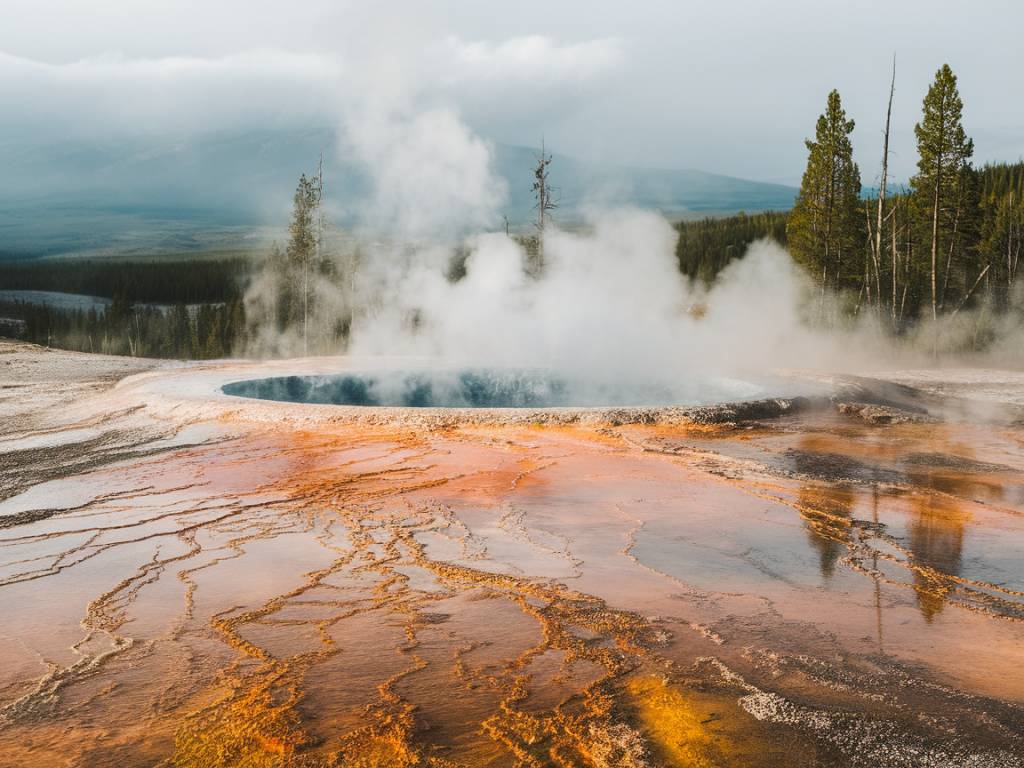The Crater Hills thermal area is one of Yellowstone’s more secluded geothermal zones, offering a unique and undisturbed look into the park’s volcanic foundation. Nestled in the northeastern part of Hayden Valley, this lesser-visited location provides a tranquil yet intriguing experience for those willing to venture off the beaten path. Despite its remoteness, Crater Hills rewards visitors with a serene atmosphere and fascinating geothermal features that rival some of the more popular locations in Yellowstone.
Geothermal Features and Activity
Crater Hills is distinguished by the presence of fumaroles, mud pots, and hot springs, all of which are common geothermal features found throughout Yellowstone. Yet, what makes Crater Hills unique is both the concentration and variety of these features within a relatively confined area. The steaming vents and bubbling pools provide a vivid reminder of the volcanic activity simmering beneath Yellowstone’s surface.
Historical Significance
The area holds historical significance dating back to the 19th century when early explorers first documented its geothermal activity. Among them was the Hayden Geological Survey of 1871, which produced some of the earliest scientific examinations and illustrations of Yellowstone’s geothermal wonders. Crater Hills was noted for its vigorous activity, and while it remains less frequented today, its historical relevance continues to play a critical role in our understanding of geothermal processes.
Wildlife Viewing
One of Crater Hills’ underrated aspects is its potential for wildlife viewing. Situated in the verdant Hayden Valley, the area serves as a habitat for an array of wildlife. Visitors may encounter bison, elk, and an assortment of bird species. The valley is also a prime location for spotting predators like wolves and grizzly bears. Observing these magnificent animals amidst the geothermal backdrop of Crater Hills offers an unparalleled experience of Yellowstone’s natural ecosystem.
Accessibility and Safety
Crater Hills is not as easily accessible as other geothermal areas in Yellowstone. It requires a bit of hiking and possibly some off-trail navigation. This remoteness ensures that the area is less crowded, but it also comes with challenges. There are no boardwalks or marked trails, making it essential for visitors to exercise caution.
Here are some safety tips:
- Stay on stable ground and avoid the ground near geothermal features, as it can be thin and fragile.
- Bring adequate water, snacks, and a first-aid kit.
- Inform someone of your plans before heading out.
- Always keep a safe distance from wildlife.
Photographic Opportunities
Photography enthusiasts will find Crater Hills to be a goldmine of unique opportunities. The interplay between geysers, thermal pools, and the surrounding landscape make for striking compositions. Early mornings or late afternoons are ideal times for capturing the area in the softer light, producing a more ethereal effect.
Thermodynamics and Geochemistry
For those interested in the science behind the beauty, Crater Hills offers a fascinating study in thermodynamics and geochemistry. The water chemistry varies significantly across the thermal features, providing insight into the subsurface geological processes. For example, the varying pH levels and mineral compositions reveal different pathways of geothermal activity.
Visitor Impact and Conservation
Given its secluded nature, Crater Hills experiences less human impact compared to other areas in Yellowstone. This has allowed its geothermal features to remain relatively undisturbed. However, it’s important for visitors to adhere to Leave No Trace principles to maintain the area’s pristine condition. Picking up after oneself and minimizing disturbances help in preserving the unique ecosystem for future generations.
Connecting with Nature
One of the most compelling reasons to visit Crater Hills is the opportunity to connect deeply with nature. The isolation and tranquility of the area provide an ideal setting for reflective moments. Whether it’s the sound of bubbling mud pots or the sight of steam ascending into the sky, the sensory experiences at Crater Hills can be profoundly grounding.
Despite its remote location, Crater Hills offers a range of experiences that cater to the adventurer, the scientist, the nature lover, and the photographer. To explore Crater Hills is to journey into a part of Yellowstone that feels almost untouched by time, a reminder of the raw and dynamic forces shaping our planet.
As you walk through this secluded thermal area, you’re not just a visitor, but a witness to the Earth’s ceaseless geothermal ballet. It’s a place that invites you to slow down, observe, and appreciate the intricate dance of steam, water, and rock. Whether you’re capturing photographs, observing wildlife, or simply soaking in the beauty, Crater Hills provides a uniquely enriching experience in one of the world’s most fascinating natural settings.
